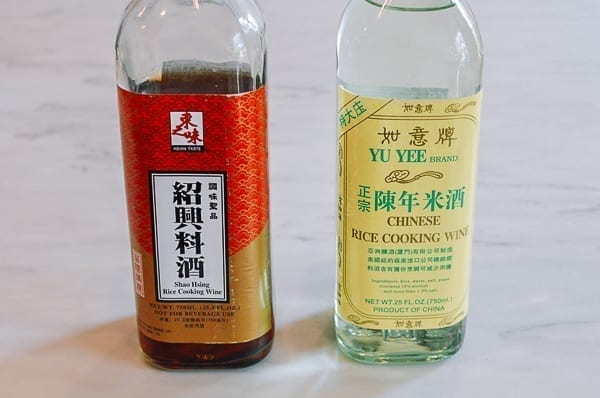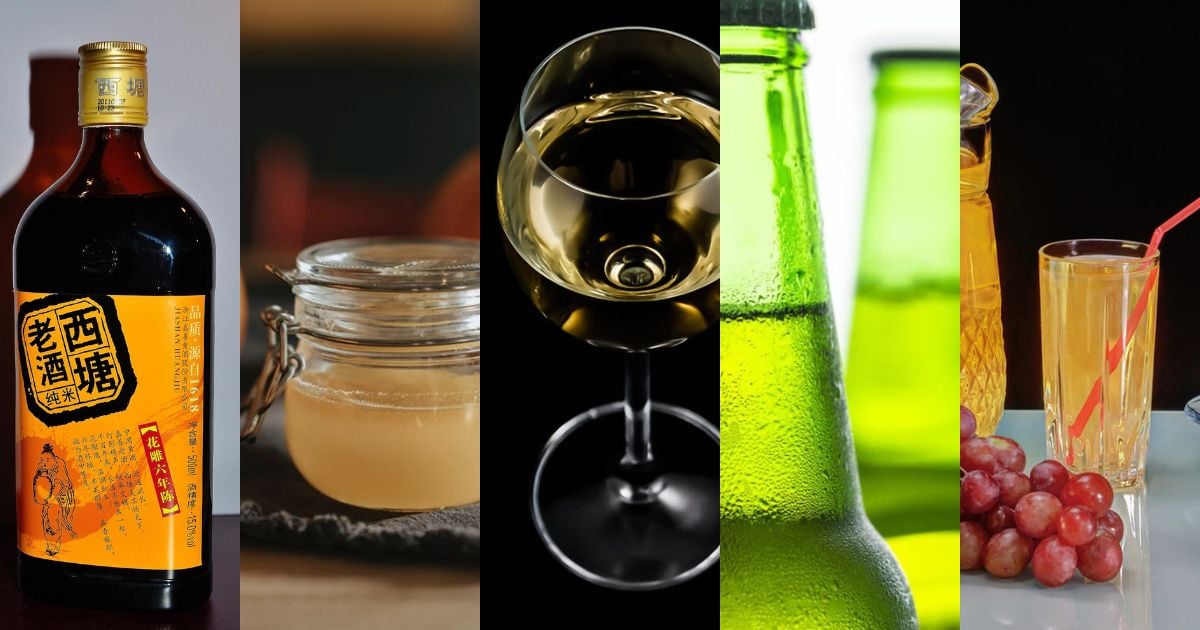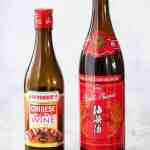
Introduction
What Is Shaoxing Wine And Its Importance In Chinese Cooking
Shaoxing Wine, also known as Chinese Cooking Wine, is a type of rice wine commonly used in Chinese cuisine. It is made from fermented glutinous rice and aged for a long time, resulting in a unique flavor profile. Shaoxing Wine is a key ingredient in many traditional Chinese dishes, providing depth of flavor and enhancing the overall taste of the dish. It is often used to marinate meats, add aroma to stir-fry dishes, and deglaze pans.
Why Find Alternatives For Shaoxing Wine
While Shaoxing Wine is widely used in Chinese cooking, it may not be easily available or suitable for everyone. Some people may prefer not to use alcohol in their cooking due to personal or religious reasons, while others may have difficulty finding Shaoxing Wine in their local grocery stores. In these cases, finding alternatives for Shaoxing Wine becomes necessary.
Using alternative substitutes, such as vinegar-based stocks or other non-alcoholic options, can still help achieve delicious results in Chinese cooking. These substitutes can provide similar flavors and help balance the taste of the dish. However, it is important to note that the exact flavor and aroma of Shaoxing Wine may not be fully replicated by these alternatives, and some adjustments to the recipe may be needed to achieve the desired taste. Nonetheless, experimenting with different substitutes can be an exciting way to explore new flavors and techniques in Chinese cuisine.
Non-alcoholic Substitutes For Shaoxing Wine
White Grape Juice
White grape juice can be used as a non-alcoholic substitute for Shaoxing Wine. It provides a slight sweetness and acidity that can help balance the flavors in Chinese dishes. However, it may not have the same depth of flavor as Shaoxing Wine and can alter the taste of the dish slightly.
Apple Juice
Apple juice is another option for replacing Shaoxing Wine in recipes. It adds a touch of sweetness and fruity flavor to the dish, which can be a pleasant addition to certain Chinese dishes. However, it is important to use unsweetened apple juice to avoid making the dish overly sweet.
Stock
If you prefer a more neutral alternative, using chicken or vegetable stock can be a suitable substitute for Shaoxing Wine. While it may not provide the same complexity of flavors, stock can still add depth to the dish and help create a well-balanced taste.
It’s important to note that while these non-alcoholic substitutes can help achieve similar results in terms of flavor balancing, they may not fully replicate the unique bouquet of Shaoxing Wine. Adjustments to the recipe may be needed to achieve the desired taste. Nonetheless, experimenting with these alternatives can be a great way to explore new flavors and adapt Chinese dishes to personal preferences or dietary restrictions.
Vinegar Substitutes For Shaoxing Wine
Apple Cider Vinegar
Apple cider vinegar can be used as a substitute for Shaoxing Wine in Chinese and other Asian cuisines. It provides a mild and slightly fruity flavor that can complement the dish. However, it is important to note that apple cider vinegar may have a stronger taste compared to Shaoxing Wine, so it should be used in smaller quantities and adjusted to taste.
White Wine Vinegar
White wine vinegar is another option for replacing Shaoxing Wine in recipes. It has a light and slightly acidic flavor that can enhance the taste of the dish. Like apple cider vinegar, white wine vinegar should be used in moderation, as its taste can be overpowering if used in excess.
It’s worth mentioning that while these vinegar substitutes can help achieve a similar flavor profile in terms of acidity and balance, they may not replicate the unique fragrance of Shaoxing Wine. Adding a splash of vinegar to your dish can enhance the overall taste, but it may not fully replicate the depth and complexity of using Shaoxing Wine in traditional recipes.
Experimenting with these vinegar substitutes can provide an opportunity to explore new flavors and adapt Chinese dishes to personal preferences or dietary restrictions. Adjusting the quantities and taste is key to achieving the desired culinary experience.

Soy Sauce Alternatives For Shaoxing Wine
Light Soy Sauce
Light soy sauce can be used as a substitute for Shaoxing Wine in Chinese and other Asian cuisines. It adds a savory and umami flavor to dishes, similar to the depth provided by Shaoxing Wine. Light soy sauce should be used in a ratio of 1:8 to 1:4 compared to the amount of Shaoxing Wine called for in the recipe. Adjust the quantity based on personal taste preference.
Lemon Juice
Lemon juice can also be used as a substitute for Shaoxing Wine, especially if you prefer a slightly tangy flavor. It adds a fresh and citrusy taste to the dish. The substitution ratio for lemon juice to Shaoxing Wine is 1:8. It is important to note that lemon juice may not provide the same depth of flavor as Shaoxing Wine, but it can still contribute to the overall taste of the dish.
Using these soy sauce alternatives can help achieve a similar taste profile to Shaoxing Wine, while also adding their unique flavors. It is important to adjust the quantities and taste according to personal preference to ensure the desired culinary experience.
Other Shaoxing Wine Substitutes
One common substitute for Shaoxing Wine is rice vinegar. It has a similar acidic and slightly sweet taste, making it suitable for various recipes. The substitution ratio for rice vinegar to Shaoxing Wine is usually 1:1, but it can vary depending on the specific dish and personal preference.
Another alternative is dry sherry, which is a readily available option. It adds a rich and nutty flavor to dishes, similar to Shaoxing Wine. The substitution ratio for dry sherry to Shaoxing Wine is 1:1, meaning you can use the same amount of dry sherry as the recipe calls for Shaoxing Wine.
Both rice vinegar and dry sherry can enhance the flavors of your dishes when used as substitutes for Shaoxing Wine. However, it’s important to note that they may not provide the exact same taste profile as Shaoxing Wine, as each ingredient has its own unique characteristics.
Experimenting with different substitutes and adjusting the quantities to suit your taste preferences can help you create delicious dishes even without Shaoxing Wine.
Using Alternatives In Specific Chinese Dishes
Stir-fries
When it comes to stir-fries, the use of Shaoxing Wine substitutes can still provide delicious results. Rice vinegar and dry sherry can bring a tangy and savory flavor to your stir-fried dishes. The 1:1 substitution ratio allows you to easily incorporate these alternatives into the recipe. Whether you’re preparing a vegetable stir-fry or a protein-based dish, these substitutes can add depth and complexity to the flavors.
Marinades
Marinades are a great way to infuse your meats or vegetables with flavor before cooking. Substituting Shaoxing Wine with rice vinegar or dry sherry in marinades can still yield tasty results. As both alternatives have their own unique flavors, you may need to adjust the quantities to achieve the desired taste. However, they can still provide the same tenderizing and flavor-enhancing effects that Shaoxing Wine offers.
It’s worth noting that while these alternatives work well in specific Chinese dishes like stir-fries and marinades, they can also be used in other recipes that call for Shaoxing Wine as an ingredient. The versatility of these substitutes allows you to explore different flavors and textures in your cooking, even if you don’t have access to Asian grocery stores or specialty shops.
Tips For Choosing The Best Shaoxing Wine Substitute
Considerations For Selecting The Appropriate Substitute
- Flavor profile: Consider the flavor profile of the substitute and how it will complement the other ingredients in your dish. Look for substitutes that have similar umami and savory notes.
- Availability: Choose substitutes that are readily available to you. Rice vinegar and dry sherry are commonly found in most grocery stores and can be easily substituted for Shaoxing Wine.
- Alcohol content: Shaoxing Wine has a relatively low alcohol content, so if you prefer to avoid or reduce alcohol in your cooking, consider substitutes that have a similar alcohol content.
- Sweetness level: Shaoxing Wine has a slight sweetness to it. If you want to replicate this sweetness, consider adding a small amount of sugar or honey to your substitute.
Recommended Ratios
- Rice vinegar: Substitute equal parts rice vinegar for Shaoxing Wine in your recipe. Adjust the quantity based on your personal taste preferences.
- Dry sherry: Replace Shaoxing Wine with an equal amount of dry sherry. This substitute works well in both stir-fries and marinades.
Remember, while these substitutes can provide similar flavors to Shaoxing Wine, they may not completely replicate the complexity of the original ingredient. However, they are versatile alternatives that can still enhance the taste of your Chinese dishes or any recipe that calls for Shaoxing Wine.

Cooking With Shaoxing Wine Substitutes
Recipe Ideas Using Alternatives
Using substitutes for Shaoxing Wine can still result in delicious Chinese dishes. Here are some recipe ideas to try:
- Stir-fried vegetables: Use rice vinegar or dry sherry as a substitute for Shaoxing Wine in your stir-fried vegetables. It will add a depth of flavor to the dish.
- Marinades: Replace Shaoxing Wine with equal parts rice vinegar or dry sherry in marinades for meats or tofu. It will help tenderize the protein and infuse it with savory notes.
- Sauce for dumplings: Substitute rice vinegar or dry sherry in the sauce for dumplings for a tangy and savory flavor.
- Braised dishes: Use dry sherry as a substitute for Shaoxing Wine in braised dishes like soy sauce chicken or braised pork belly.
How To Adjust Flavors
When using Shaoxing Wine substitutes, it’s essential to adjust the flavors accordingly. Here’s how:
- Flavor profile: Consider the substitute’s flavor profile and how it complements the other ingredients. Look for substitutes with similar umami and savory notes.
- Quantity: Substitute equal parts rice vinegar or dry sherry for Shaoxing Wine in your recipes. Adjust the quantity based on personal taste preferences.
- Sweetness: If you want to replicate Shaoxing Wine’s slight sweetness, add a small amount of sugar or honey to your substitute.
Remember, while these alternatives can provide similar flavors, they may not entirely replicate the complexity of Shaoxing Wine. Nevertheless, they are versatile substitutes that can enhance the taste of your Chinese dishes or any recipe that calls for Shaoxing Wine.
Cooking With Shaoxing Wine Substitutes
Recipe Ideas Using Alternatives
When it comes to cooking with Shaoxing Wine substitutes, there are various options available that can still result in delicious Chinese dishes. Here are some recipe ideas to try:
- Stir-fried vegetables: Use rice vinegar or dry sherry as a substitute for Shaoxing Wine in your stir-fried vegetables. It will add a depth of flavor to the dish.
- Marinades: Replace Shaoxing Wine with equal parts rice vinegar or dry sherry in marinades for meats or tofu. It will help tenderize the protein and infuse it with savory notes.
- Sauce for dumplings: Substitute rice vinegar or dry sherry in the sauce for dumplings for a tangy and savory flavor.
- Braised dishes: Use dry sherry as a substitute for Shaoxing Wine in braised dishes like soy sauce chicken or braised pork belly.
How To Adjust Flavors
When using Shaoxing Wine substitutes, it’s essential to adjust the flavors accordingly. Here’s how:
- Flavor profile: Consider the substitute’s flavor profile and how it complements the other ingredients. Look for substitutes with similar umami and savory notes.
- Quantity: Substitute equal parts rice vinegar or dry sherry for Shaoxing Wine in your recipes. Adjust the quantity based on personal taste preferences.
- Sweetness: If you want to replicate Shaoxing Wine’s slight sweetness, add a small amount of sugar or honey to your substitute.
Remember, while these alternatives can provide similar flavors, they may not entirely replicate the complexity of Shaoxing Wine. Nevertheless, they are versatile substitutes that can enhance the taste of your Chinese dishes or any recipe that calls for Shaoxing Wine.
Summary Of Shaoxing Wine Substitutes
To summarize, here are the key points to remember about Shaoxing Wine substitutes:
- Substitutes such as rice vinegar or dry sherry can be used in place of Shaoxing Wine in various recipes.
- These substitutes bring their own unique flavors to dishes and can add depth and complexity.
- When using substitutes, it’s important to adjust the flavors by considering the substitute’s flavor profile, adjusting the quantity, and adding sweetness if desired.
- While substitutes may not replicate the exact taste of Shaoxing Wine, they offer versatility and accessibility in cooking.
FAQ: Substitution for Shaoxing Wine: Finding Alternatives in Chinese Cooking
Q: What is Shaoxing wine?
A: Shaoxing wine is a type of rice wine originating from the Shaoxing region in China. It is an essential ingredient in many Chinese recipes, adding flavor and aroma to various dishes.
Q: Can I substitute Shaoxing wine with other types of wine?
A: Yes, you can substitute Shaoxing wine with other types of wine if you don’t have it on hand. Dry sherry, mirin, huangjiu (yellow rice wine), or even a combination of rice vinegar and water are popular alternatives.
Q: What is dry sherry, and how does it compare to Shaoxing wine?
A: Dry sherry is a fortified wine from Spain. It has a similar flavor profile to Shaoxing wine, characterized by its nutty and slightly sweet notes. While not an exact substitute, dry sherry can be used in recipes that call for Shaoxing wine.
Q: What is mirin, and how can I use it as a substitute?
A: Mirin is a sweet Japanese rice wine commonly used in cooking. It has a milder flavor compared to Shaoxing wine, but its natural sweetness can work well in many Chinese dishes. When substituting, use 3 parts mirin to 1 part water to mimic the lower alcohol content of Shaoxing wine.
Q: How does huangjiu compare to Shaoxing wine?
A: Huangjiu, also known as yellow rice wine, is a traditional Chinese rice wine. It shares similarities with Shaoxing wine, although the flavor profile may vary between different brands and varieties. Huangjiu can be used as a substitute in most recipes that call for Shaoxing wine.
Q: Can I use rice vinegar as a substitute for Shaoxing wine?
A: Yes, you can use rice vinegar as a substitute for Shaoxing wine, but it is best to dilute it with water in a 1:1 ratio. This mixture helps mimic the subtle flavors of Shaoxing wine without overpowering the dish with vinegar’s acidity.
Q: Are there any non-alcoholic alternatives to Shaoxing wine?
A: If you prefer a non-alcoholic substitute, you can use chicken or vegetable broth mixed with a pinch of sugar and a dash of soy sauce. This combination can lend a similar umami and savory flavor to your dish.
Q: Are the substitutions for Shaoxing wine interchangeable in every recipe?
A: While these substitutions can work well in many recipes, it’s important to note that each alternative offers slight variations in flavor. It’s always best to consider the specific flavor profile and regional origin of the recipe you’re preparing. Experimentation and personal taste preferences may also play a role in determining the best substitute.
Q: How should I store Shaoxing wine and its alternatives?
A: Shaoxing wine should be stored in a cool, dark place, like a pantry or cellar. Once opened, it can last for several months if kept tightly sealed. Alternatives like dry sherry, mirin, or rice vinegar can be stored in the refrigerator after opening, following the instructions on the bottle.
Q: Where can I find Shaoxing wine and its alternatives?
A: Shaoxing wine is widely available in Asian grocery stores and some well-stocked supermarkets. Alternatives like dry sherry, mirin, and rice vinegar can also be found in these stores or online retailers specializing in Asian ingredients.
Remember, while substitutions can offer a similar taste, they may not capture the exact essence of Shaoxing wine in every recipe. It’s always worth trying different options to find your preferred flavor profile in Chinese cooking.
